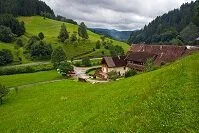Geography, Weather, & Wildlife of Germany
Geography

Black Forest
Germany is located in Europe, arguably in either Western Europe or Central Europe. It is a large country (relative to its European neighbors) and stretches from the North Sea and Baltic Sea in the north to the Alps in the south. Germany borders the Netherlands (west), Belgium (west), Luxembourg (west), France (west), Switzerland (south), Austria (south), the Czech Republic (east), Poland (east), and Denmark (north).
Geographically, Germany is very diverse as the northern stretch of the country is low-lying and a number of large rivers run through this part of the country including the Elbe River, Rhine River, and Rhone River. About half way to the country's south the mountains begin to rise as these rivers flow in the lowland valleys. The far south is covered with the rise to the Alps as some areas are fairly mountainous, while others are simply at elevation or are slightly lower due to rivers, such as the Danube River, flowing through. This abundance of rivers creates fertile growing conditions and a high population density throughout much of the country.